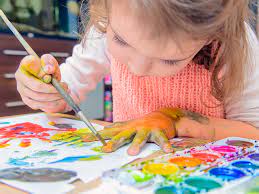What Activities For Children Can Promote Imagination and Creativity Fostering imagination and creativity in children is crucial for their cognitive development and problem-solving skills. Encouraging them to think outside the box and explore their creative potential can be both fun and educational. Here are some activities for children that promote imagination and creativity:
Artistic Expression:
-
- Drawing and Coloring: Provide children with a variety of art supplies such as colored pencils, markers, crayons, and paper. Encourage them to draw whatever comes to mind, whether it’s fantastical creatures, dreamy landscapes, or abstract designs.
- Painting: Watercolors, acrylics, and finger paints can open up new avenues for self-expression. Let them experiment with different techniques and materials.
Storytelling:
-
- Create a Story: Encourage children to invent their own stories or fairy tales. They can use props, toys, or even act out their stories with family and friends.
- Illustrate Stories: After creating a story, have them illustrate it with their artwork. This combines storytelling with visual creativity.
Imaginative Play:
-
- Dress-Up: Keep a collection of costumes, hats, and accessories on hand for imaginative dress-up play. Children can transform into pirates, superheroes, explorers, or anything their imagination desires.
- Pretend Play: Encourage role-playing activities like playing house, restaurant, or doctor. This allows children to create scenarios and characters using their imagination.
Building and Construction:
-
- Building Blocks: Provide building blocks or construction toys like LEGO sets. Children can build their own structures, vehicles, and worlds from scratch.
- Cardboard Creations: Collect cardboard boxes, tubes, and other recyclable materials, and let children craft their own creations, such as forts, robots, or castles.
Nature Exploration:
-
- Outdoor Adventures: Take children on nature walks or hikes where they can observe plants, insects, and animals. Encourage them to sketch what they see or create nature-inspired art.
- Gardening: Involving children in gardening activities, such as planting flowers or vegetables, not only teaches them about nature but also allows them to express themselves through gardening designs.
Music and Dance:
-
- Musical Instruments: Introduce children to musical instruments like keyboards, drums, or simple percussion instruments. They can experiment with sounds and rhythms.
- Dance and Movement: Encourage spontaneous dance and movement to music. Children can make up their own dances or choreograph routines.
Science Experiments:
-
- Kitchen Science: Simple kitchen experiments can be both educational and fun. Allow children to mix ingredients and observe chemical reactions, which can spark their curiosity and creativity.
Creative Writing:
-
- Journaling: Encourage children to keep a journal where they can write stories, poems, or daily reflections. Journaling allows them to express themselves in written form.
- Letter Writing: Encourage children to write letters to friends, family members, or even fictional characters. This helps them practice writing while using their imagination.
Collage and Mixed-Media Art:
-
- Collage Making: Provide magazines, newspapers, and old photographs for children to create collages. They can cut out images and arrange them into imaginative scenes or abstract art.
- Mixed-Media Art: Combine different art materials like paint, paper, fabric, and found objects to create unique artworks.
DIY Craft Projects:
-
- Craft Kits: Invest in age-appropriate craft kits that allow children to create jewelry, pottery, or other crafts. These kits often come with instructions to follow or can be customized.
Remember that the key to nurturing imagination and creativity in children is to provide a supportive and non-judgmental environment where they feel free to explore, experiment, and let their imaginations run wild. Encourage their ideas and praise their efforts to boost their confidence and enthusiasm for creative activities.



